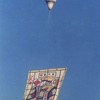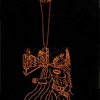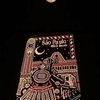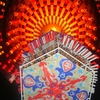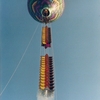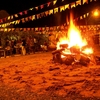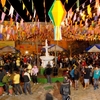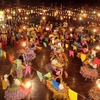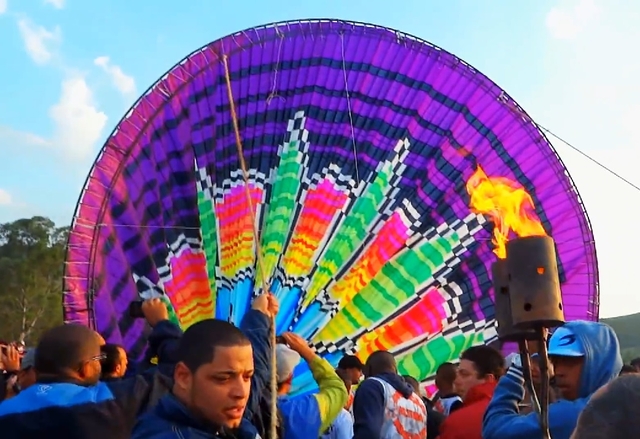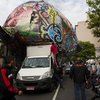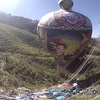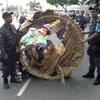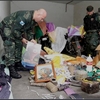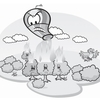An Art of Air and Fire: Brazil’s Renegade Balloonists
Imagine waking up early on Sunday morning to the sound of loud explosions. Growing up in São Paulo in the 1990s, these explosions were often my weekend alarm clock. But the rude awakening was not at all reason for distress—rather, it was reason for joy and excitement. I would jump out of bed and run to the backyard, usually bumping into my older brothers, who were doing the same. The strange succession of bursts and explosions, we knew, could only mean one thing: balloons!
Soon we would be sitting on the fence, in our pajamas, scanning the sky for huge balloons—preferably with grandpa’s old binoculars—for a closer inspection. The alarm clocks were easy to spot: balloons carrying enormous racks full of hundreds of fireworks of all sorts. They left huge trails of smoke in the sky, continuing their pyrotechnic displays sometimes for half an hour. But it was not all explosions. Some balloons bore long paper banners with intricate designs ranging from abstract patterns to the likeness of musicians and celebrities, someone’s girlfriend or mother, or, on many occasions, Jesus Christ. Those were silent, and if they were high up enough, you really had to look for them—and use the binoculars for a closer peek at their design.
Balloon with fireworks flying in São Paulo.
My favorites were the night balloons. Sometimes they carried fireworks too. But the most beautiful were the ones that carried light panels: nets of candlelit paper lanterns in a multitude of colors, precisely arranged to form a drawing lit by fire in the night sky. Fireworks, banners, and light panels are not the only cargo of these Brazilian balloons. Some, for instance, carried hundreds of kite-like paper gliders (released by a fuse) which would slowly flutter down all over a neighborhood, providing endless entertainment for children who chased and captured them.
Thousands of these balloons roam the skies of São Paulo and Rio de Janeiro every year. Yet there is one thing these balloons do not carry: people. They certainly could—many of them are powerful enough to lift ten adults up and away. But that’s not the point. These balloons are not made for transportation. They are a folk art. They are meant to display the craft of their makers to their community, and beyond.
Paper balloons propelled by torches have been a staple of Brazilian culture for centuries. They started as tiny contraptions in colonial times, only few feet high, launched during traditional parties to celebrate St Anthony, St Peter, and St John (all of which, in the Catholic tradition, have their holy days in June). In Brazil, these festivities came to be known as festas juninas, or June festivals. They feature bonfires, balloons, and fireworks that, according to tradition, are used to wake up St John.
Such celebrations have persisted in contemporary Brazil. And so have the balloons. Yet during the twentieth century, these flying works of folk art strayed from the path of traditional religious festivities. Organized in uniformed teams, baloeiros, as the balloonists are known in Brazil, made their craft a separate subculture. Looking to make even bigger, more complex, and awe-inspiring works of flying folk art, baloeiros beginning in the 1960s joined together in teams. By the 1980s, some balloons were as tall as 216 feet, and could carry hundreds of pounds of banners, light panels, or pyrotechnic displays. The art of ballooning had reached its golden age.
But the unchecked ambitions of the baloeiros brought about their downfall. In the 90s, environmentally-conscious politicians started seeing the gigantic balloons as threats, flying arsonists that could cause forest fires. In 1998, “the manufacture, transportation and launching” of balloons became a federal crime, punishable by fines and up to three years in prison. Once symbols of national folk culture, the balloonists now became criminals.
But that didn’t stop them.
Of Paper, Glue, and Popular History: Creating Balloons
The process of creating a balloon starts with an idea. Typically, the more artistically inclined baloeiro on a team sketches designs. The next step is to choose a shape, and create a mold on which the design can be transferred. While traditionally this was all done by hand, nowadays baloeiros work with several software tools as well as online databases of previous designs.
Once the design is complete, the extremely laborious process of piecing the balloon together starts. The complex designs you see in the photos are not painted or drawn on the balloon: each swath of color is a hand-cut piece of paper. Each piece is cut and glued together in a process that takes months. It is a very ephemeral art. Indeed, most of the enjoyment of ballooning lays in the crafting itself. A team will work for months to create a balloon, and then only get to watch it for some thirty minutes before its shape becomes indistinguishable in the sky.
Once the balloon is complete, the baloeiros work on a propulsion system. There is a delicate balance to be achieved here: the balloons are made of paper, but propelled by fire. For this purpose, a metal ring is created and affixed to the bottom opening of the balloon, known as the boca, or mouth (people who interfere with a launch by loitering around the opening are jokingly referred to as dentistas). The metal ring has a center shelf where the torch is loaded, keeping it away from the paper sides. Even though this structure is not visible once the balloon is launched, teams sometimes take great pains to embellish them, creating wire sculptures to hold the torch—a proper altar for the pyre which will take their beloved craft to the skies.
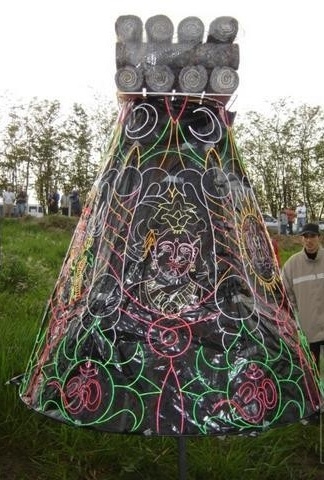
Baloeiros often lavishly decorate the metal structure that holds the torch, making them into sculptures.
Balloons have holy origins, and their fuel source continues to offer a link with the sacred. The torches that propel these aircraft are usually made of cotton or some cloth soaked in paraffin wax. Catholic churches and cemeteries are full of candles. Balloonists often raid cemeteries at night to collect bags full of candles to be melted for their fuel. Jokes about holy candles abound. In one interview I conducted with balloonists demonstrating the process of making balloon torches, they pulled no punches when it came to their paraffin wax sourcing:
[Balloonist #1] This wax is pretty good… A little black though.
[Balloonist #2] That’s just some dirt.
[Balloonist #3] Nah, that’s holy wax, from the church.
[Balloonist #2] Yeah, that balloon will go up pre-blessed.
[Balloonist #3] Yep, the prayers are built in.
[laughter]
[Interviewer] I guess that balloon is going straight to God then?
[Balloonist #3] Just light it and it will go straight up. Those candles are miraculous!
[laughter]
The candles are sourced from churches and cemeteries, melted, then spread over a thick sheet of cotton or cloth. The excess wax is squeezed out, and the cloth is rolled up into a log. The logs are arranged and piled on the central metal structure, and voila—you have a powerful torch that can heat the air in the balloon for several hours.
There is one thing balloonists like almost as much as making balloons—talking about them. Despite the fact that launching balloons is now a federal crime, there are myriad publications and resources about balloons. Some traditional balloon magazines have existed since the early 1980s. There are photographers specializing strictly in balloons—balógrafos—who sell balloon photo books and launch footage DVDs, available anywhere from street stalls to the internet. Searching for “balão” on YouTube will bring up endless hours of footage. Sometimes these balógrafos are even hired to create balografias (yes, a balloon bibliography) of a team’s entire history of launches, much like a family might commission a genealogy. Balloon teams are indeed much like families, and often consist of actual blood families and their closest friends and in-laws.
I stated above that despite the prohibition there are lots of materials on balloons out there. But one might rejoin that it is precisely because of this repression that baloeiros are so fond of commemorating their history. The balloons do indeed have a long history, and it seems that proving their deep connections in Brazilian culture and religion serves as a legitimizing force, as arguments for their wholesomeness, and their legalization.
The most commonly made association is with the festas juninas, the annual parties celebrating St Anthony, St Peter, and St John. These festivities hail from medieval Portugal, where they supplanted or hybridized with pagan celebrations of the summer solstice. A central feature of these celebrations, a huge bonfire, is a holdover from their pre-Christian past. But in early modern Portugal, the parties also came to include something that baloeiros claim Marco Polo imported from China—balloons. The celebration, as imported to Brazil in colonial times, already included these elements.
In Brazil, where June is also mid-winter, the bonfires and balloons became especially important features (balloons fly better in winter, where the relative density of the cold air outside and the hot air inside propels them with vigor). The parties also came to take on a particular aesthetic and form. Everyone wears costumes modeled after the Brazilian version of a “country bumpkin”—a caipira—perhaps out of nostalgia in what is today a primarily urban country. Traditional foods are served, and the adults drink quentão, a local version of mulled wine with an extra kick provided by cachaça, a Brazilian sugarcane liquor. Children are paired in couples, and lined up to have a priest marry them in mock weddings. And of course, small balloons are launched.
The festas juninas are such wholesome and traditional celebrations that baloeiros often emphasize the balloons’ origin in these festivals as evidence that their art form is rooted in Brazilian culture—and could never be eradicated. But in legitimizing their art, defenders of the balloons have reached much further in history too, mixing it with a perceived Brazilian pioneerism in the invention of flight itself, and even with the idea that pre-Columbian peoples also took to the skies in balloons.
In the mid-twentieth century, a common hero for baloeiros (and the theme for many of their balloons) was Alberto Santos-Dumont. He was a Brazilian who, by flying an aircraft in 1906 Paris, is believed almost unanimously in Brazil to be the inventor of the airplane. For baloeiros taking to the sky with crafts of their own, Santos-Dumont was a hero who legitimized their own ascent to the skies. Baloeiros looking for legitimacy also range as far as the early eighteenth century. In 1709, Bartolomeu de Gusmão, a Brazilian priest, demonstrated a small balloon at the court of the Portuguese king—securing the exclusive patent to create a manned version of the craft (the king also passed an edict prohibiting the use of balloons to flee the country). Baloeiros often cite this as the first test of a balloon as airship. Brazilians in general like to discredit the Wright Brothers in favor of Santos-Dumont, and baloeiros, it seems, often discredit the Montgolfier Brothers, globally known for creating the first manned balloon in Paris, in favor of Bartolomeu de Gusmão.
Some take the search for the historical grounding of their art form even further back. One example is the claim that the balloon has pre-Columbian origins in the Americas. The argument is based on the notion that the kilometers-long Nazca drawings supposedly could not have been designed without the advent of flight. Erik Von Däniken, in his pseudo-scientific book Chariots of the Gods (a popular hit in Brazil), assigns the cause for such drawings to the presence of extraterrestrial beings. But the baloeiros could not let aliens take their glory. Humberto Pinto, writing for the baloeiro magazine Gazeta do Balão, claims instead that it was the work of Andean balloonists. The claim rests on a successful 1975 experiment to recreate and fly the Nazca balloon based on a vase painting in a Lima museum and the materials available at the time. Not even aliens could take credit for the balloonists’ hallowed past.
Bigger, Better, Louder: Launching the Golden Age of Balloons
The launch of a balloon demands an early rise. In order to avoid stronger winds and take advantage of the still air, baloeiros begin congregating on a launch field as early as four in the morning. They start with basic preparations, such as unfolding the balloon, preparing the payload, and turning on the maçarico, a propane torch, to start inflating the balloon. As the crowd starts to gather, they sometimes enjoy some quentão, the mulled wine drink common in festas juninas—after all, it can get pretty chilly on early winter mornings in São Paulo and Rio de Janeiro, where most balloons are launched. The baloeiros are readily distinguishable from the dentistas and other bystanders by their team uniforms and striped winter hats.
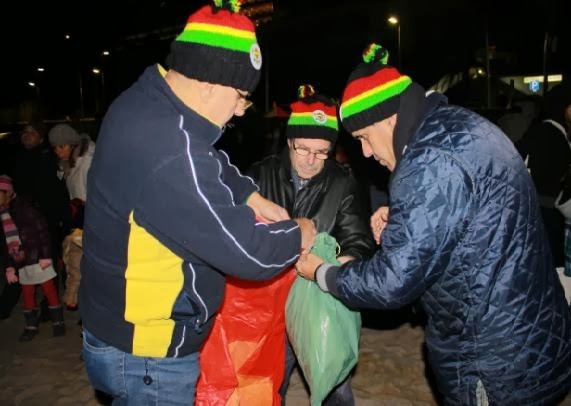
Baloeiros preparing for a launch, using the characteristic striped winter hats that teams often share as part of their uniform.
As it fills with hot air, the balloon starts to inflate. Baloeiros carefully hold the paper open around the mouth, so that the torch does not touch it. Once the balloon is inflated enough, it rises to stand vertically. But for big balloons, there is still a long way to go before it is ready. To maximize efficiency, the balloon is often lowered to the ground, so that hot air does not escape, leaving a lone baloeiro inside the balloon with a propane tank and torch. While his friends stand outside holding the balloon in winter jackets, the balloonist with the torch sometimes has to strip down because of the heat inside.
With the balloon fully inflated, the fuel structure lit, and payload attached, the tense moments prior to launch start with a crowd standing at attention, combined with the very raucous noise of the team yelling commands back and forth at each other to carefully coordinate their movements. Some baloeiros hold the lines that control the balloon’s ascent, sometimes in groups to avoid being lifted off the ground, while others hold the folded banner or prepare to light the fuse for the fireworks. They hold and slowly release the line until the payload starts to lift off the ground. Banners slowly begin to unfold. Racks of fireworks hover just above the ground with a lit fuse. The heightening tension of this crucial moment is reflected by an increasing cacophony of voices coordinating the launch. At last, all voices are yelling the same command: libera! (release). The moment after they let go of the guide lines is full of joyous celebration, teammates alternating between watching the balloon and hugging each other. Applause, whistling, and yelling dominates the atmosphere. After months of arduous preparation, the baloeiros—and their families, friends, and community—get to admire the artistic details for a short time, until only the silhouette of the distant balloon is distinguishable.
This scene is a far cry from the earlier, more primitive balloons of festas juninas. Those little balloons, launched by the dozens, were just a few sheets of paper glued together. One person would hold it, and another light the torch with matches, and off it went. But as ballooning evolved into its own folk art form, separating from the religious tradition, the balloons became ever bigger and more complex. By the early 1970s, they were reaching a golden age, with large balloons, creative designs, and innovative techniques. The secular balloons, once limited to teams in just a few communities, spread like wildfire—by the early 1980s there were hundreds of teams in Rio de Janeiro and São Paulo. Two factors marked this incredible growth in the practice of launching balloons: the creation of new techniques for building larger balloons, and the sharing of this knowledge among an increasing community of baloeiros.
The most critical changes were technological advances that permitted bigger balloons, and consequently heavier payloads. Unlike older balloons that carried simple banners or no payload at all, balloons now also featured racks of fireworks and sometimes complex light panels.
The use of propane torches to inflate balloons is one example of an improvised technology. Traditionally, baloeiros would hoist up the balloon with bamboo poles, and then inflate it with an electric fan or a small ground fire—something that severely limited the size of balloons and the time allowed for the preparation of payloads since the fuel torch had to be lit quickly in order to heat the air inside the balloon. The idea of using propane torches came from metal workers and other laborers who were also baloeiros (most balloon teams hail from working class neighborhoods). With propane torches inflating the balloons on the ground, they could be kept inflated while the team made preparations, and most importantly, this allowed much bigger balloons to be launched.
The environment around the working class neighborhoods of baloeiros inspired many other impromptu innovations. One Rio de Janeiro fisherman and balloonist came up with the idea to use fishnets as structures to hold the lanterns in nocturnal light panels, a much lighter alternative to the wooden sticks previously used.
Baloeiros encountered other problems on their march towards a trend of gigantismo. With the propane torches enabling bigger balloons, many of the teams that pushed the size barrier found months of work ending in galinhas pretas—black chickens—the term for the feather-like floating pieces of charred paper when a balloon fails and burns. Their tops would open, sides would rip, but nothing seemed to subdue the desire to advance in size. Soon new methods for reinforcement were created, gluing lines wherever two pieces of paper met, and tying all the lines at the top to increase the balloon’s structural strength.
These exchanges of knowledge and technique further reinforced the kinship groups that baloeiro teams were creating. In fact, the flight of the balloons themselves could create new relationships between teams. In an interview regarding balloons in the seventies, Odair Bueno recounts how he spent a few years admiring certain balloons with complex panels, unlike anything he had seen before, rising from the other side of a nearby hill. Eventually, Odair chased one of the balloons, and in attempting to retrieve it he met its creator, who happily shared his techniques over a Saturday afternoon beer. A São Paulo team, for instance, met baloeiros from a team they were unaware of based just a few kilometers away in a struggle to retrieve a balloon landing in their neighborhood. In learning of each other’s manpower and resources, such as a bigger garage and workbench, they formed a new, combined team with a new emblem and uniform, United Baloeiros. These sorts of connections and alliances further increased the ability to create bigger and better balloons.
These hard-won advances gained through collaboration among the teams in the urban peripheries of São Paulo and Rio de Janeiro created the modern Brazilian balloon. By the late seventies, the new form of ballooning was becoming well known. Commerce devoted to balloons flourished: neighborhood stores sold supplies like paper, glue and fireworks, creating meeting places where baloeiros could sit for a beer and discuss their craft. Specialized photographic shops, which balógrafos worked at or owned, became the art galleries of the suburbs, places where baloeiros would go to admire the work of other groups, and learn from them. The modern balloon was born, and as stunning specimens flew over city centers—and the people in the elite areas of Rio and São Paulo started taking notice.
The activity, technically speaking, had long been illegal. Colonial laws prohibited balloons in São Paulo during dry season, and a 1934 national forestry code also prohibited the practice. But these laws were unknown and largely ignored. As Brazilians say, these laws were just para inglês ver—for the English to see—which is the expression for when something is done for the sake of appearances.
The authorities seldom enforced the law, doing so usually only when a baloeiro stood out for some reason. As an example, the famous João Ely once made a tribute balloon to Walt Disney, who had recently died. Walt Disney company executives went to Rio to film the launch. Due to the publicity, a court delivered an injunction warning him not to proceed. A Disney executive contacted the embassy, which mobilized a variety of local politicians to achieve a compromise in order to allow Ely to launch the tribute balloon—with the condition that he would keep it tethered to the ground.
Ely did not keep his end of bargain, since the notion of tethering a balloon seemed sacrilegious. He let the Disney balloon fly away in the presence of a distinguished crowd of politicians, embassy functionaries, Disney executives, and even local police chiefs who came to watch the launch. Despite Ely’s disregard for official orders, the crowd applauded. Dr. Celitte Rangel, a chief in the feared Social and Political Police, once explained the lack of repression in a newspaper interview: “It seems some laws are made to be broken. Is there anyone that thinks that balloons are immoral?”
Lawyer Oswaldo Mendonça explained that a good deal of “important people” were admirers of the balloon art, like a prosecutor who, not being able to show up at launches, would send his own balógrafo into the suburbs to document the art. In the interview, even Rangel admitted that the newly military-appointed president, João Figueiredo, had a baloeiro as a friend. In fact, a baloeiro launched a tribute in honor of the president’s inauguration. President Figuereido was unabashedly captivated by balloons. In 1984, the last year of the military dictatorship, he received a Christmas postcard of a balloon made to honor America Futebol Clube, his wife’s favorite soccer team. He responded with a personal note handwritten on his presidential stationery, thanking “Dearest Ivo”—Ivo Patrocínio, a famous Rio baloeiro—and wishing him a great, and less turbulent, year in 1985. It was the year that would see Brazil’s first civilian president since 1964. President Figuereido was not the only authority to give the balloons his blessing. After the 1980 earthquake in Italy, the Zodíaco team in Rio sent pictures of a balloon they had made in honor of Pope John Paul II to the Vatican, as an act of empathy. They received two gracious letters back from the Vatican’s secretary of state thanking them for the well wishes.
Even public institutions embraced balloons as a national art form. São Paulo’s Department of Culture hosted a balloon exhibit, keeping multiple balloons inflated with continuous fans inside a warehouse for months. The gallery was a hit: more than two thousand people visited every weekend. The exhibition, a resounding success, was titled “Balloons: The Art of Air and Fire,” and featured baloeiros as curators, who even received certificates from the Department of Culture.
Tragically, and ironically, the same cultural center that hosted this exhibition was eventually set ablaze when a balloon landed on its roof. This only reinforced a notion that became widespread after the golden age of balloons—that balloons were a threat to modern urban life. But this fear of balloons, mostly held by people living in the elite central areas of the cities, had been growing since the late eighties, as balloons became bigger and bigger. The late eighties saw the reestablishment of political democracy in Brazil, but the golden age of balloons was coming to an end, and soon the state would be repudiating the work of baloeiros as an antiquated, irresponsible, and criminal activity.
Landing in Concrete and Disgrace: The Criminalization of Balloons
This is not a crime
This is our art!
True baloeiros decorating the skyline
—“Baloeiro Funk” by MC Coruja (Rio de Janeiro)
I am baloeiro, I am
concrete plan emerges from paper
and flies, coloring the skies […]
always united, by the law persecuted
our culture is our resistance
I am baloeiro, I am!
—“Baloeiro Rap” by Rapper Cleyton (São Paulo)
What comes up must come down. And when balloons come down, they are not alone—but rather followed by dozens of balloonists trying to get it back.
The process of retrieving balloons, the resgate (rescue), is as old as the balloons themselves. The successful retrieval of an entire balloon allows for a second launch, an especially advantageous benefit considering some bigger balloons take months to build. Resgates also help prevent fires since a dedicated group of baloeiros on the scene will recover the balloon, remove it from roofs or power lines, and ensure that no damage ensues. Also, they are seen as a fun and adrenaline-filled activity for young men, who will chase them even if they are not baloeiros themselves. Historically resgates have been a very cordial and organized process, regimented by an unwritten code of conduct. The first rule is that a flying balloon has no owner: anyone who reaches a landing balloon first can keep it to make a second launch. Second, if more than one crew reaches it at the same time, or if multiple groups collaborate on the retrieval, they make an impromptu lottery, with a member of each team entering the lottery to see who keeps the balloon.
But by the early nineties the cordiality of this process was breaking down. With the standardization of techniques allowing initiates to make bigger balloons, the number of teams increased sharply. And unlike in the past, where teams were centered around family units with a moderating patriarch, now many teams were composed of restless young men in a violent world. To understand the changes within the world of baloeiros, we need to look to the chaotic nineties in Brazil.
Crime, soccer riots, vandalism, arson of public transportation, and many other aspects of Brazilian urban life helped create a sense of generalized violence and fear. In 1995, three people died in a soccer match between Palmeiras F.C. and São Paulo F.C. when fans used the construction materials at the stadium for an all out mêlée on the field. In 1996, commuters set ablaze three train stations in São Paulo, along with the parked trains, because the trains were late and people could not get to work. In Rio de Janeiro, drug gangs solidified their control over the city’s favelas, and often used heavy weaponry against police. The historical memory of the nineties in urban Brazil is replete with seemingly unnecessary violence. This everyday violence was visible not only in increased crime rates, but also, as the history of balloons shows us, even in popular culture.
Carlos Pimenta’s study of organized soccer fan clubs and their aggressive behavior suggests that young men, for various reasons, formed collective associations that often used violence as a means to express an identity. Balloon teams, like organized fan clubs, provided a space for socialization. With the spread of the art due to technical advancements and standardization of techniques, a new generation of younger baloeiros emerged. The new teams, composed of young men who pursued the activity on their own, did not have the familial and kinship ties that were prevalent in earlier groups, where there was a greater dependence on a veteran baloeiro, or crew patriarch. They did not necessarily need this voice of experience as much of the technical knowledge became codified and well known.
Baloeiro magazines were full of stories of violent encounters. One letter to the editor warned that “after the retrieval of a 5x5 balloon […] the Lua Cheia team was forced out under bullets by the Esquina crew: let us all be on the lookout.” In the early morning hours of October 6, 1988, unknown baloeiros approached members of the Emoção team during a resgate. The unknown baloeiros identified themselves by the name of their neighborhood, and wielded knives and pistols—the balloon was uncared for due to the confrontation and it burned. The members of the Emoção team left the scene, writing in to a baloeiro magazine to say that they were “fathers and family heads and our lives are not worth risking with these bandits,” suggesting that other baloeiros in the same situation should restrain themselves and not fight such individuals, since they would “not think twice before shooting.”
Baloeiros were not the only ones noticing this trend towards violence. Major newspapers and police tabloids also picked up reports of hostile baloeiros. The stories did not seem out of place within a journalistic world where, as one popular song warned, “we have popular dailies that one never wrings for fear of spilling—paged, indexed blood baths.” Headlines such as “Man Executed by Bullets in Struggle Over Balloon” were common in a world where “criminals,” guilty or not, were executed by police, where riots, death and senseless bloodshed were staples in the news. But the press expressed other concerns that went beyond the unfriendly behavior of urban youth in the pursuit of balloons. The ever-growing size and quantity of balloons landing throughout the city was also worrisome, and the mainstream press aggressively voiced these concerns.
Unlike in the golden age of the seventies, when most newspaper reports about baloeiros were positive portrayals, there was now bad press and mixed reactions. Perhaps one of the best examples is a letter written June 13, 1986 to the Folha da Tarde newspaper. The reader complained that his neighborhood was left without power after an incident with a balloon, and that in his opinion, baloeiros should be sentenced to at least one year in prison. The newspaper columnist, sarcastically responding to the reader, wrote that he had a confession: he loves balloons and thinks that festas juninas cannot go on without them, so “please direct all complaints to the editor-in-chief.”
But violence and the risk of fires were becoming troublesome issues for baloeiros, and the press more frequently reported on the risks of balloons. Such fires were not only an urban concern. Environmentalists also started blaming baloeiros for putting nature preserves at risk. Rio de Janeiro’s Floresta da Tijuca and São Paulo’s Mata Atlântica are some of the largest urban forests in the world. Many started pointing out that balloons flying over the concrete and green jungles of São Paulo and Rio de Janeiro could just as easily land in the green areas and destroy environmental protection areas.
In fact, resgate stories from baloeiros reveal that they did indeed often retrieve balloons from forests. One group of balloonists interviewed by the Planeta Balão magazine recounted a story where they had to negotiate over a balloon not with other balloonists, but rather with Indians. The balloon was launched in São Paulo and headed towards the coast, going down the coastal range and over the Mata Atlântica forest, landing in an indigenous reservation. According to their narrative, the Indians threw rocks at them while they climbed the trees to get the balloon. Much like they did with the police in the city, the baloeiros pulled their money together to bribe the Indians with $60 to retrieve the balloon.
TV news increasingly reported sensationalistic stories of the dangers of ballooning, and public opinion started turning against baloeiros. The proliferation of the balloons had made them more dangerous, and soon there were calls for prohibition. That day finally came.
June 1992 was different than most June months in Rio de Janeiro, when the greatest numbers of balloons go up into the skies. The army was present on security duty in the streets of Rio, as delegates and heads of state from dozens of countries converged in the city for ECO-92, a United Nations convention on environmental policy for the twenty-first century. As with many such environmental meetings, there were great differences in opinion from the representatives of developed and developing countries as to who should bear the burdens of policy change in the environmental arena.
The Brazilian state, as steward of the Amazon, took up various ecological responsibilities in its planned policy changes, including new environmental legislation. Congress passed the new law, and President Fernando Henrique Cardoso signed it in March of 1998. Law 9.605/98 included an article directed towards baloeiros. The now famous Article 42 outlawed the “manufacture, possession or launch of balloons” and penalized it with fines and up to three years in prison. The reasoning for this, as in the previous 1934 forestry code, was the danger of forest fires posed by balloons. The police enforced the new federal balloon law with increased vigor.
Regulating baloeiro activity wasn’t entirely new. In fact, various other laws had forbidden the launch of balloons on a local scale. Authorities, however, mostly ignored them and the regulations went unenforced. Laws regulating fires, fireworks, and balloons in public celebrations and festas juninas go back to colonial times. In São Paulo alone, there were prohibitions of such fiery manifestations of popular culture in 1610, 1641, 1689 and 1695. The repetitive issuances of such regulations indicate that not even in colonial times did the law stop men from celebrating their saint’s day with displays of fireworks and balloons. In some ways, the 1998 law intended to end a centuries-old tradition in its modern form, but much like its colonial counterparts, it failed to extinguish this “rooted tradition,” as baloeiros often refer to their art. Balloons still fly in large numbers in Brazil today. It did, however, embolden opponents of the balloon.
It was the end of the golden age of balloons.
The criminalization of the balloon caused a change in attitude not only from the authorities, but also in the media, and consequently, a larger section of the general population as well. Unlike earlier newspaper reports that praised the art and curiously peered into the world of baloeiros, interviewing them and showing their craft, journalists moved balloons from the culture section of the paper to the crime and police pages. An extensive search through TV and paper reports on balloons reveals that almost every report was about a police raid apprehending what they now called “safe houses,” the garages or workshops of baloeiros. The TV reports on balloons now took the exact format of police reporting. It is very customary for instance, in cases of drug raids, for the officers to pose with the contraband and weapons captured. The same now happens with balloons: police officers stand in front of the cameras, talking about their raid, with piles of paper, glue, ropes, fireworks, and a folded balloon behind them. Some cities have even created a Disque-Balão (Balloon Crime Hotline) for citizens to anonymously report on balloon launches or workshops.
TV Record, a major television network, even went as far as making an hour-long documentary decrying the horrors of balloons. Although mostly rehashing the typical concerns about fires and the violence in resgates, it also brought up another major concern: the role of balloons flying in the congested airspace of the city. The civil aviation authorities started taking balloons very seriously, and the documentary included sound bites from radar air traffic controllers in Rio forced to treat balloons as air traffic, stating their positions to pilots in the same way they would report the position of any other aircraft to direct a pilot around it. One can only imagine what international airline pilots must think when the control tower instructs them to change course in order to avoid a huge balloon with a pyrotechnic show hanging underneath it.
The first recorded instance of a balloon-aviation incident harkens back to the golden age. In 1979, a Rio baloeiro launched a balloon with a half size model airplane glider as a payload, to be released at high altitude by a fuse. People saw the enormous model plane crash, and called the police. Civil aviation authorities rushed to the scene of the crash only to find a wooden model.
Since the prohibition, the invasion of airspace by balloons has grown into a major concern. More recently civil aviation authorities have designed educational materials to be distributed to children in schools. The leaflets were in comic book format, with evil balloons putting unsuspecting forests and airplanes at risk. The authorities were trying to extinguish the tradition by preventing a new generation of baloeiros—an illusory goal, considering that these traditions are often passed down from father to son. Also, balloons have a long tradition in Brazilian childhood, including a nursery rhyme:
Fall fall balloon,
Fall fall balloon,
Right here on my hand,
Please don’t fall,
Please don’t fall,
Don’t fall at soap street.
Some well known baloeiros have tried to organize in order to address some of the criticism and lobby for the legalization of the balloon. In 1998, they founded the Sociedade Amigos do Balão (Society for Friends of the Balloon, or SAB) with that very goal in mind. Some SAB members have proposed a solution similar to one which regulated Carnaval decades ago: the construction of the sambódramo, an official stadium-like arena where parades can be held. The SAB proposed a balódramo outside the city, with stadium seating, where balloons could be launched at designated times in a regimented fashion regulated by the state government. The balódramo is the solution that comes the closest to resolving air traffic issues, since the airspace around it could be reserved much like it is for other aerial sports, such as the manned hot-air ballooning practiced elsewhere in the world.
Like in their golden age, balloonists also sought to improve their techniques—this time not to make bigger balloons, but rather safer balloons. The Rio de Janeiro government, for instance, made an exception for allowing a balloon festival, provided that the balloons could be made visible by air traffic radar. The online magazine Planeta Balão quickly prepared a white paper for baloeiros so they could adapt to this requirement. They used information from the Brazilian Air Force’s Aeronautics Technological Institute to figure out a design for a radar reflector to be built for just $5 from aluminum foil. They also introduced new metal rims for the torches—these would now be covered by electrical tape so as to not short circuit power lines when landing in the city.
Today, some baloeiros hold dear the notion that they can use their guerrilla technology to make the balloon once again acceptable. Responding to the charges of the state and environmentalists that balloons cause fires, they have created a new genre: the fireless balloon. These baloeiros created a system in which they inflate the balloon with a propane torch and then seal the opening without fire inside.
These balloons would have lift, but would lose it quickly as the air cooled, a problem that prompted yet another innovation. They added a payload that consisted of a full water cooler, with a small opening at the bottom. The timed draining of the water slowly made the balloon lighter, compensating for the loss of lift due to the cooler air, and maintaining the craft at a stable altitude. The eco-friendly fireless balloons have had some success. There are now state-sanctioned annual festivals for fireless balloons. But the practitioners of “green” ballooning are a minority of the estimated 40,000 baloeiros in the cities of Rio de Janeiro, São Paulo, and Curitiba. Many believe that fire is the essence of the art, often saying that “fire is the soul of the balloon.”
We don’t know what the future holds for baloeiros. Much like balloons rise and fall, baloeiros came from modest roots, launched into an explosive phenomenon, and then were criminalized. It seems that for now, they remain in a state of suspension.
The research for this article was prepared for a documentary on the subject, filmed by Appendix editors Felipe Cruz and Benjamin Breen along with filmmaker Desi Hernandez. The documentary will be released in 2015.




